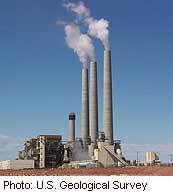- Navigating Your Midlife Crisis: Embracing New Possibilities
- City Raccoons Showing Signs of Domestication
- Mapping the Exposome: Science Broadens Focus to Environmental Disease Triggers
- One Week Less on Social Media Linked to Better Mental Health
- Your Brain Changes in Stages as You Age, Study Finds
- Some Suicide Victims Show No Typical Warning Signs, Study Finds
- ByHeart Formula Faces Lawsuits After Babies Sickened With Botulism
- Switch to Vegan Diet Could Cut Your Greenhouse Gas Emissions in Half
- Regular Bedtime Does Wonders for Blood Pressure
- Dining Alone Could Mean Worse Nutrition for Seniors
Obama Moves to Cut Power Plant Emissions


The Obama administration announced plans Monday that would require the United States to cut power plant emissions that many scientists blame for global warming by 30 percent by 2030.
It’s a move that would substantially improve the health of millions of Americans, federal officials said.
The plan targets the biggest source of carbon pollution in the country — more than 600 coal-fired power plants, according to the U.S. Environmental Protection Agency.
“Today climate change that is fueled by carbon pollution is supercharging risks not just to our health but to our communities, to our economy and to our way of life,” EPA Administrator Gina McCarthy said during a news conference Monday morning.
“Currently, there are no limits on carbon pollution from power plants — our nation’s largest source. For the sake of our families’ health and for our kids’ future, we have a moral obligation to act on climate change,” she said.
McCarthy said “rising temperatures bring more smog, more asthma and longer allergy seasons,” and added that “carbon pollution from power plants comes packaged with dangerous pollutants, like particulate matter, nitrogen oxides and sulphur dioxide. And they put our children and our families at even more risk.”
The proposal, which is already stirring opposition from Republican lawmakers and some business groups, “will result in lower medical bills, fewer trips to the emergency room, especially for those kids who have asthma, our elderly and our infirmed,” McCarthy said.
The 645-page proposal, scheduled to be ready by next year, is a key piece of Obama’s efforts to combat climate change. It also seeks to give the United States more credibility with other countries when negotiations on a new international treaty resume next year, the Associated Press reported.
The proposal is probably Obama’s last chance to substantially reduce the greenhouse gas emissions that many scientists blame for trapping heat in the atmosphere and warming the planet, The New York Times reported. The President failed to get Congress to enact a broad climate change bill during his first term. This time around, he’s using his executive authority under the 1970 Clean Air Act to issue the regulation, the newspaper said.
The American Lung Association called the President’s decision a major step toward improving the health of the nation.
Association President Harold Wimmer said, “Power plant pollution makes people sick and cuts short lives.”
According to Wimmer, the new rules would reduce the burden of air pollution in America, prevent up to 4,000 premature deaths and 100,000 asthma attacks in the first year, and prevent up to 6,600 premature deaths and 150,000 asthma attacks in 2030.
“Cleaning up carbon pollution will have an immediate, positive impact on public health — particularly for those who suffer from chronic diseases like asthma, heart disease or diabetes. Steps to clean up carbon pollution can reduce sulfur dioxide and nitrogen oxides, both poisonous emissions from coal-fired power plants that are also major precursors to lethal ozone and particulate matter pollution,” he said.
According to the U.S. Centers for Disease Control and Prevention, air pollution is a leading environmental threat to health. Health problems linked to air pollution include more emergency room visits and hospital stays for breathing and heart problems, worsening of asthma, low birth weight, decreased lung growth in children, lung cancer and early deaths.
The EPA also said the new rule would cut electricity bills roughly 8 percent by promoting energy efficiency and reducing demand in the electricity system.
“We don’t have to choose between a healthy economy and a healthy environment — our action will sharpen America’s competitive edge, spur innovation, and create jobs,” McCarthy said.
The plan is already coming under fire by industry groups and some lawmakers. The U.S. Chamber of Commerce said the new rule would “cost America’s economy over $50 billion a year between now and 2030.”
Karen Harbert, president and CEO of the U.S. Chamber of Commerce’s Institute for 21st Century Energy (Institute), said, “Our analysis shows that Americans will pay significantly more for electricity, see slower economic growth and fewer jobs, and have less disposable income, while a slight reduction in carbon emissions will be overwhelmed by global increases.”
The proposal has also been the target of criticism from Republicans — and even some Democrats — engaged in tight campaigns in energy-producing states, the AP reported.
Sen. Mitch McConnell, R-Kentucky, called the proposal a “dagger in the heart of the American middle class.” He said it would mean higher costs, fewer jobs and a less reliable energy grid, the Times reported.
The EPA said it would accept comments on the proposal for 120 days after it is published in Federal Register and will hold four public hearings during the week of July 28. The hearings will be in Atlanta, Denver, Pittsburgh and Washington, D.C. The agency said it would then finalize the standards next June, based on the schedule established in the June 2013 Presidential Memorandum.
More information
For more on air pollution, visit the U.S. National Library of Medicine.
Source: HealthDay
Copyright © 2025 HealthDay. All rights reserved.










